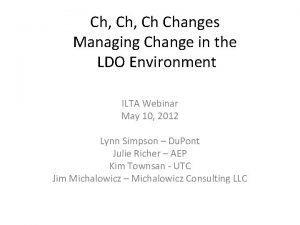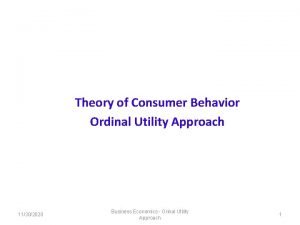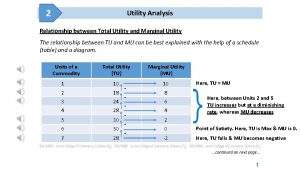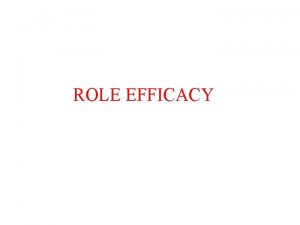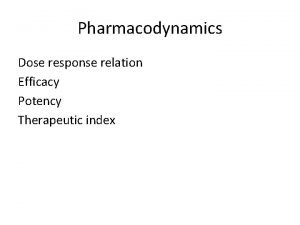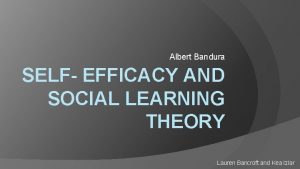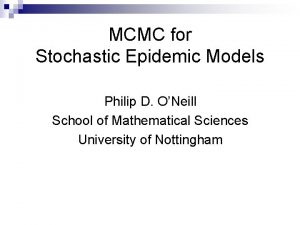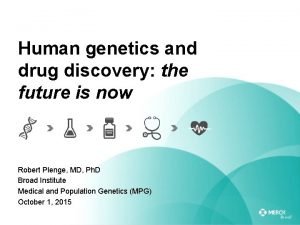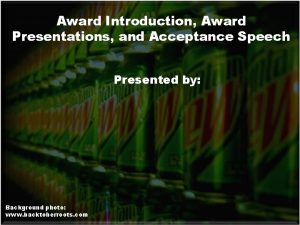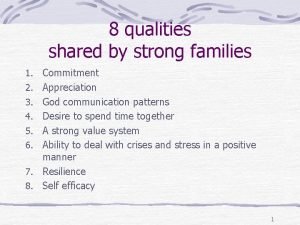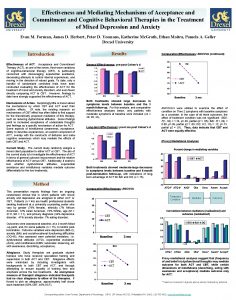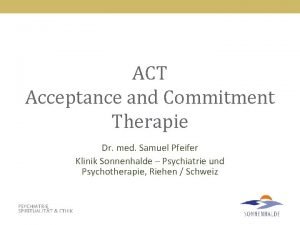On the Utility and Efficacy of Acceptance Commitment






































































- Slides: 70

On the Utility and Efficacy of Acceptance & Commitment Therapy for Adults with Developmental Disorders Ruth Anne Rehfeldt, Ph. D, BCBA-D Behavior Analysis and Therapy Program Southern Illinois University

Objectives • Provide an overview of Acceptance and Commitment Therapy (ACT) and some examples of representative experiential exercises • Discuss how ACT might be adapted and applied for individuals with developmental disabilities and their caregivers • Showcase research on the use of ACT in conjunction with ABA for clients & staff • ACT IS ABOUT HEALTHY, ADAPTIVE LIVING FOR EVERYBODY, it is not just a treatment for psychopathology.

Why ACT? Life moves pretty fast. If you don't stop and look around once in a while, you could miss it. — Ferris Bueller Live as if you were to die tomorrow. Learn as if you were to live forever. — Gandhi

Avoiding The Happiness Trap & Live a Life According to your Values:

Valued Living: Domains I am living fully by my values I am out of touch with my values EDUCATION LEISURE X X PERSONAL HEALTH (Lundgren; Harris, 2008) RELATIONSHIPS

Values • In ACT, the goal is for individuals to live a valued life. • “chosen paths that the individual defines as important and meaningful. ” • Actions & qualities of actions, so stated as verbs: “Give generously; ” • Not things we have, or nouns: “A fashionable wardrobe. ” • “a life driven by values is characterized by fullness, purpose, and vital engagement” • *Values aren’t ever achieved, unlike Goals. EX: I value enjoying classical music. A goal may be to obtain a 2 nd MS in music.

Valued Domains (Hayes, 2005) • • • Marriage/couple/Intimate Relationships Parenting Other family relations Friendship/social relations Career/employment Education/training/personal growth Recreation/leisure Spirituality Citizenship Health/Physical well-being

Myths about Happiness: • #1: Happiness is the Natural State for All Human Beings • High prevalence of suicide; probability of any of us suffering from a psychiatric disorder in our lives is 30%. Nearly 100% of all people at some time contemplate suicide. • #2: If You’re Not Happy, You’re Defective • ACT assumes unhappiness is a normal part of being human • #3: To Create a Better Life, We Must Get Rid of Negative Feelings: • Our struggle to get rid of negative feelings is what creates unhappiness. • #4: You Should Be able to Control What you Think and Feel • The more we try to control our thoughts and feelings, the more unhappiness it creates **Laboratory studies have shown that our moods can drastically change at the drop of a hat. Yet they have the ability to make or break our very existence!

Psychological Flexibility & Inflexibility • Ability to contact the present moment fully • Psychological inflexibility involves responding rigidly to one’s internal experiences to the point where an individual is not living a life in accordance with what he or she values, often through the avoidance of painful thoughts or feelings (experiential avoidance) • Psychological inflexibility can restrict an individual’s behavioral repertoire and reduce opportunities for external reinforcement, leading to a compromised quality of life (Bluett et al. , 2014) • Standardized measures have been correlated with symptoms of a number of psychological disorders

Individuals with Developmental Disorders • Poor social skills; limited relationships • As adults, challenges for independent living and employment • Long history of receiving services • Possible history of abuse and neglect • Stress in parents or staff • *All may make psychological inflexibility likely • SOME STATS: – 10 -40% of all people with developmental disorders in community settings have a diagnosed mental health condition (www. thearcww. org/helpline) – 20 -30% of all noninstitutionalized adults with intellectual disabilities are dually diagnosed (Graziano, 2002) – High prevalence of anxiety and depression in teens & adults with ASD

Psychological Inflexibility in Staff • Focusing on psychological flexibility in the workplace may help reduce a number of common organizational problems (Bond et al. , 2010) • Why is this important among staff working with individuals with developmental disorders? – Up to 1/3 of front-line staff report stress levels indicative of a mental health problem (Hatton et al. , 1999) – Work may be tedious, monotonous, or frustrating = inadequacy – Staff shortages, lack of high quality training – Varied job duties as services become more community based – Clients’ well being is affected by staff interactions • Reports of stress, job burnout, & depression were lower among early childhood special educators, and they showed a willingness to adopt new practices and procedures (Biglan et al. , 2011) following ACT interventions

Acceptance & Commitment Therapy (ACT) • Goal is to increase psychological flexibility • Addresses “language and cognitive processes so that an open-centered, engaged approach to living is pursued” (Hayes, Strosahl, & Wilson, 2011) • Based upon six core processes to enhance psychological flexibility

ACT is Evidence-Based • • • Eating Disorders Chronic Pain Traumatic Brain Injury Obsessive-Compulsive Disorders Anxiety Disorders Depression Substance abusers People with Schizophrenia Work Dissatisfaction, i. e. , STAFF! PTSD patients **Developmental Disabilities (including IDD & ASD; staff and parents) = recent publications


Acceptance • Willingness: “the voluntary and values-based choice to sustain contact with private experiences or the events that will likely occasion them” • Psychological Acceptance: “the adoption of an intentionally open, receptive, flexible, and nonjudgmental posture with respect to moment-to-moment experience” (Hayes, Strosahl, & Wilson, 2012)

Illusion of Control: • Try not to think about your favorite flavor of ice cream! • Don’t Think About a Puppy • Horror Movie Example: “Do The Point: Thoughts, feelings, Not Feel Afraid!” sensations, and memories are NOT that easy to control.

Common Thought Control Strategies that Get us in Trouble: Flight Strategies: • Hiding/Escaping • Distraction • Zoning out/Numbing Fight Strategies: • • Suppression Arguing Taking Charge Self-Bullying The Problem with control: --Do you use them excessively? --Do they prevent you from doing the things you value?

The Costs of Experiential Avoidance: • Complete this sentence: • The thoughts/feelings I’d like to most get rid of are……” • Now, think about strategies you used to get rid of those thoughts/feelings: • DID THEY HELP IN THE LONG-RUN? • WHAT DID IT COST YOU IN TERMS OF TIME, ENERGY, MONEY, ETC. ? • DID YOUR STRATEGIES BRING YOU CLOSER TO A MORE MEANINGFUL LIFE? OUCH! • AVOIDANCE OF PAINFUL THOUGHTS/FEELINGS HURTS!

Examples showing that Experiential Avoidance Doesn’t work (Hayes, 2005): • Metaphor of the Hungry Tiger • Metaphor of The Chinese Finger Trap Metaphor of Quicksand: So give yourself a break and stop struggling.

Room Full of Duct Tape • Picture your life as a room. One day you notice that a pipe near the ceiling in a corner is dripping. The sound of the falling drops makes you nervous, and you’d like to get rid of it. So you repair the leak with a length of duct tape and your peace of mind is back – until the water finds its way through the tape and the dropping sound is back: plop…plop…So you put another length of tape around the first repair and it’s quiet again. • Of course, the peace and quiet doesn’t last very long. You have to fix the leak again and again. That’s not a big problem since duct tape is pretty cheap and you always manage to keep a spare roll handy. This goes on for months or even years until one day you notice that these big clumsy repairs are slowly filling the room, leaving less and less space for you to live in and bringing the dripping nearer and nearer to you. • IS AVOIDING THOSE THOUGHTS GETTING YOU CLOSER TO YOUR BULLS’ EYE? • (Philippe Vuille, 2013)

Ball in a Pool • What if what you’re doing with these thoughts, memories, and feelings is like fighting with a ball in a pool? You don’t like these things. You don’t want them, and you want them out of your life. So you try top push the ball under the water and out of your consciousness. However, the ball keeps popping back up to the surface, so you have to keep pushing it down or holding it under the water. Struggling with the ball in this way keeps it close to you, and its tiring and futile. If you were to let go of the ball, it would pop up and float on the surface near you, and you probably wouldn’t like it. But if you let it float there for a while without grabbing it, it could eventually drift away to the other side of the pool. And even if it didn’t, at least you’d be able to use your arms and enjoy your swim, rather than spending your time fighting. • (Matthew Jepsen, 2012)


Cognitive Fusion & Defusion • Fusion: “the pouring together of verbal/cognitive processes and direct experience such that the individual cannot discriminate the two…. . when fused, we formulate a situation symbolically and then organize our behavior to fit the demands of the rules that we are programmed to follow. ” • “In a fused state, a person can follow the same rule over and over again and never really recognize that the desired results are not occurring” • Defusion: “making closer contact with verbal events as they really are, not merely what they say they are…. . Changing the functions of language…. ” (Hayes, Strosahl, & Wilson, 2012)

Your Mind Tells Stories: When you are “Fused, ” you are “Believing” those stories! Imagine the feel, smell, and taste of a lemon Imagine reading a great thriller These Thoughts and Feelings are Like Stories Imagine 2 different newspapers’ reporting of the same crime. Imagine a documentary about Africa THEY ARE ALL STORIES! STORIES ARE NOT THE EVENT “Fusion”: to blend, or meld together. We are often fused with our thoughts and feelings. We react to our thoughts and feelings as though they are the real thing, when thoughts are just stories. • This was important for evolutionary reasons. Our minds are in overdrive !! • •

When we are Fused with our Thoughts, it seems like: • • • Thoughts are reality Thoughts are the truth Thoughts are Important Thoughts are Orders Thoughts are Wise Thoughts can be Threats BUT REMEMBER: when we are fused with our thoughts, we often try to control them. Control strategies often cause more problems and DON’T WORK.

Let’s work on ACCEPTING those thoughts and LETTING THEM BE since we know that control strategies often get us into trouble: • • • We need to become DEFUSED from our THOUGHTS: “I’m having the thought that ……” Musical Thoughts Walk with your Thoughts Funny Voices or Name that Toon Give it a name and put it on a Picture a Scene on a t shirt or a stamp • In a state of DEFUSION, we see that thoughts are not always helpful or important; they may not be wise; and they are never threats. Our goal is not to get rid of the thoughts, but recognize them for what they are: Stories.

More Defusion Strategies: • • Don’t take thought seriously (banana example) Hands as Thoughts Thanking your Mind Bubbles exercise • In a state of DEFUSION, we see that thoughts are not always helpful or important; they may not be wise; and they are never threats. Our goal is not to get rid of the thoughts, but recognize them for what they are AND KEEP TAKING COMMITTED ACTIONS TOWARDS A VALUED LIFE.

Eilers & Hayes (2015) from RADD • Showed a decrease in problem behaviors as a function of cognitive defusion exercises plus exposure • Participants were 3 3 -7 year old children diagnosed with ASD with a variety of behavioral excesses (transitions; presence or absence of another person or object; performing tasks in same way; circumscribed interests) • Defusion exercise (Silly Voices) 30 s prior to exposure to a target situation or stimuli. • Access to preferred item following 5 min of exposure


Contact with the Present Moment • Present Moment Awareness • “Present-moment processes are about living flexibly in the here and now” • “Skillful intentional allocation of attention” Mindfulness interventions (John Kabat-Zinn) connect most closely with this concept (left side of hexaflex)

Mindfulness: • Based on Eastern Meditation – A way of paying attention and directing focus • Involves observing one’s thoughts, but not judging or evaluating them. • Expand, or make room for your feelings • Awareness of is different from thinking about it. • Expand be willing for the feeling to be present. • Just notice!

Notice Five things • Useful when you find that you have been disconnect and need to bring yourself back to the present moment 1. Pause for a moment 2. Look around and notice 5 objects you can see 3. Listen carefully and notice five sounds you can hear 4. Notice five things you can feel against the surface of your body

Awareness of Breath Balloon Exercise • Notice your breathing • Notice the rise and fall of your rib cage • Observe how the air moves in and our of your nostrils • Notice how your lungs expand • Feel the air fill your lungs and follow the air back out as the lungs deflate

Evaluating Vs. Observing • Evaluating – Judging people, yourself, places, or things – Good vs. Bad – Subjective • Observing – Noticing – Using all 5 senses to observe a situation – Objective

More “Active” Mindfulness Exercises • Eating a raisin – Listen to different objects • “Seeing Clearly”

Mindfulness Plus Defusion • Cup exercise • Verbally abuse the cup! (get fused to thoughts about the cup!) • Step back and notice the cup

Evidence for the Efficacy of Mindfulness with Individuals with Developmental Disorders: • Decreases in aggression in school settings by adolescents with conduct disorder following mindfulness training (Singh et al. , 2007) • Low frequency, high intensity aggressive behavior decreased in an individual with mild IDD and MI (Singh et al. 2003)

Evidence for the Efficacy of Mindfulness with Parents & Staff: • Individuals with profound multiple disabilities showed increases in affect associated with happiness after staff received mindfulness training (Singh et al. , 2004) • Aggression, noncompliance, and self-injury all shown to decrease in children with ASD after parents received mindfulness training (Singh et al. , 2006)

Brazeau, et al. (submitted) On the effects of mindfulness, defusion, and behavioral skills training on job interviewing skills in dually-diagnosed adults with developmental disorders • Purpose: examine efficacy of mindfulness & defusion in improving performance during job interviews with three adults with dev. Disorders (two of whom were dually diagnosed).

Background • Poor social skills is a common obstacle to securing meaningful employment in adults with developmental disorders (Siperstein et al. , 2014) • The job interview is a major obstacle • Many studies have focused on BST to teach job interviewing (ie. , Morgan et al. , 2014) • Needed are approaches that target the private emotional experiences of adults with developmental disorders who are job interviewing – Higher levels of anxiety associated with higher cognitive functioning (55%+ of individuals with ASD have an anxiety disorder; Davis et al. , 2008) – Many adults with developmental disorders avoid anxietyprovoking situations where one’s deficient social repertoire is evident (White et al, 2009) – Much evidence for efficacy of ACT in adults with anxiety, typically measured on questionnaires and role plays (Codd et al. , 2011)

Participants • Mark: 20 year old male with Tourette’s syndrome, OCD, ADHD, and GAD. IQ of 89. • Owen: 20 year old male with ASD, Bipolar disorder, and ADHD. IQ of 77. • Christina: 21 year old female with specific learning disorder and ADD. IQ of 73. • *All reported extreme levels of anxiety regarding job interviewing and had difficulties accomplishing practice interviews • *All showed many overt indicators of anxiety during practice sessions (fidgeting; shaking hands and feet; minimal eye contact)

Experimental Design & Variables • Multiple Baseline across participants • Independent Variable – Application of mindfulness (all), defusion (Christina), & BST (Owen & Christina) • Dependent Variable – Performance on interview checklist during mock interview sessions – Each interview session contained at least five questions drawn from a set of questions established prior to the study; no feedback delivered



Intervention • Sessions consisted of a Mindfulness or defusion exercise followed by an interview session • MINDFULNESS: – Mindful Breathing (Zettle, 2007) – Mindful Body Scan (Walser & Westrup, 2007) – Mindful Walking (Stoddard & Afari, 2014) DEFUSION: – – Hands as thoughts Boat on the Water Name that Toon (Harris, 2008) • A BST procedure (instructions, modeling, rehearsal, & feedback)was conducted for two of the three participants for a few steps when skills on the question-asnwering portion of the checklist did not show improvement



• Mark: • Baseline: mean percentage of responding was 50% • Intervention: mean percentage of responding was 86% • Owen: • Baseline: mean percentage of responding was 48% • Intervention: mean percentage of responding was 84% • Christina: • Baseline: mean percentage of responding was 45% • Intervention: mean percentage of responding was 64%

Percentage of Steps Completed on Comfort Level Portion of Checklist

Pre and Posttest (State Social Anxiety)


Values and Committed Actions • In ACT, the goal is for individuals to live a valued life. • “chosen paths that the individual defines as important and meaningful. ” • Actions & qualities of actions, so stated as verbs: “Give generously; ” • Not things we have, or nouns: “A fashionable wardrobe. ” • “a life driven by values is characterized by fullness, purpose, and vital engagement” • *Values aren’t ever achieved, unlike Goals. EX: I value enjoying classical music. A goal may be to obtain a 2 nd MS in music.

What are goals (committed actions)? • Goals (or committed actions) can be completed or achieved • Checked off the to do list • Getting a master’s degree; learning a foreign language; learning a new skill, etc. • To live a valued life, one must remain consistently engaged with values and commit to certain actions. • This means setting new goals • Identify 3 committed actions that would move you closer to the bulls’ eye.

Valued Living: Domains I am living fully by my values I am out of touch with my values EDUCATION LEISURE X X PERSONAL HEALTH (Lundgren; Harris, 2008) RELATIONSHIPS

Valued Living: • Values vs Goals (or Committed Actions) – Values cannot be achieved, we can only work towards them • You cannot control your thoughts, BUT - • You can control your actions! • In Which direction would you like to head?

Psychological Well-being and Values • Bond et al. (2006): People who are NOT acting according to their chosen values are likely denying themselves contact with positive reinforcers that foster good mental health and successful performance at work • People with chronic pain who engaged in activities consistent with their values reported higher levels of physical and emotional functioning (Mc. Cracken & Yang, 2006) • Changes in values and committed actions correlated with seizure reduction in patients with epilepsy (Lundgren et al. , 2008) • Lower likelihood of suicidal ideation among those Veterans who were able to identify their values (Bahraini et al. , 2013)

The Heroes Exercise – Intended to help clients identify personal qualities that are important to them as a way to start a conversation about values. (Video) – IN A GROUP: • List the qualities of that hero • Find picture on the internet, if available, of that hero, or bring to session • Make a list of what YOU could do to portray the qualities of that hero. What actions? List as committed actions. Archer, 2013; as cited in Stoddard & Afari, 2014)

Personal Job Ad Exercise • Intended for putting individuals in touch with their values • IN GROUP: Talk about real job ads and examples; explain the idea of personal job ads; create one; keep and post. • Name and motto: • Personal qualities: • Talents: • Values: • Ambitions: • Anything else you wish for: • Jobs that need not apply: • One thing you cannot compromise on: MY VALUES! Archer, 2013; as cited in Stoddard & Afari, 2014)

Castro, Rehfeldt, & Root (in press, JCBS) On the Role of Values Clarification and Committed Actions in Enhancing the Engagement of Direct Care Workers with Clients with Severe Developmental Disorders • Purpose: Establish a functional relationship between values and committed action trainings and direct-care staff interactions with clients (using objective and reliable measures of behavior change)

Participants Three direct care staff members at an adult rehabilitation facility; worked in separate classrooms and observed to engage infrequently with clients. – Monica • 71 year old female • 28 years employment at facility – Jennifer • 36 year old female • 2 year employment at facility – Amanda • 39 year old female • 8 year employment at facility

Response Measurement • Dependent Variable – The instances of staff engagement with clients during a 15 min observation • Staff Engagement – Initiated engagement without verbal or gestural prompts for attention from individuals within classroom. – Be within two feet from the individual, physically oriented, and providing verbal and/or gestural engagement that met the individuals needs. – Demands placed or remarks from across the room would not be considered as engagement

Three-tier multiple baseline design

Workshops • Workshop Series 1 – Three 20 -40 min sessions – Centered on work values • Workshop Series 2 – Three 20 -40 min sessions – Centered on the value of client interactions • During each session, three to four individuals participated along with the participants during both Values Workshop 1 and 2 • Values clarification exercise (Bulls’ Eye; Cycling Race) assessed current values and how close one is to moving towards that value (Harris, 2013; Lundgren, Luoma, Dahl, Strosahl, & Melin, 2012)

Modified Cycling Race (Vuille, 2013) • Original purpose is to use the context of a bicycling race and the t shirts one may wear as a discussion for values and committed actions • Here, our focus is on sports events for charities (ie. , special Olympics) and the shirts one may wear, as well as the company shirts an individual may wear when he or she attends work • How do the “t shirts one wears” reflect one’s values? • Paper (or real) t shirts are then created.


Figure 2. Participants’ frequency of engagement with clients during baseline and following Workshop Series 1 and 2.

Implications • All participants showed an increase in the frequency of their engagement with clients from 11 -16 instances of engagement relative to their baseline levels • All rated the workshops favorably • Functional relationship using objective, reliable measures of behavior change • Values workshops permitted for much to be learned about staff and how they viewed their work values from a managerial perspective

Final Thoughts: • Biglan & Embry (2013) described functional contextualism as a values-driven science that possesses the tools for achieving cultural change. • One small day treatment facility is a culture in and of itself, one that is ripe for the sort of “cultural change that contributes to improving the well-being of all people” that Biglan and Embry (2013, p. 2).

Thank You for Your Time! • Any questions? Comments? • Dr. Ruth Anne Rehfeldt – rehfeldt@siu. edu – KEEP MOVING AND KEEP BREATHING!

On the Utility and Efficacy of Acceptance & Commitment Therapy for Adults with Developmental Disorders Ruth Anne Rehfeldt, Ph. D, BCBA-D Behavior Analysis and Therapy Program Southern Illinois University
 Change curve+awareness+understanding+acceptance+commitment
Change curve+awareness+understanding+acceptance+commitment Ordinal utility and cardinal utility
Ordinal utility and cardinal utility Relation between marginal utility and total utility
Relation between marginal utility and total utility Self monitoring in organisational behaviour
Self monitoring in organisational behaviour Role efficacy
Role efficacy Potency vs efficacy
Potency vs efficacy Potency vs efficacy
Potency vs efficacy Nebidos
Nebidos Optimal self-confidence
Optimal self-confidence Conclusion of breastfeeding
Conclusion of breastfeeding Collective teacher efficacy
Collective teacher efficacy Collective teacher efficacy
Collective teacher efficacy Collective teacher efficacy
Collective teacher efficacy Albert bandura self-efficacy
Albert bandura self-efficacy Vaccine efficacy
Vaccine efficacy Vaccine efficacy
Vaccine efficacy Drug efficacy
Drug efficacy Luminous efficacy comparison chart
Luminous efficacy comparison chart Drug efficacy
Drug efficacy Efficacy therapy
Efficacy therapy Efficacy potency
Efficacy potency Offer and acceptance
Offer and acceptance Offer and acceptance
Offer and acceptance What is a discount house
What is a discount house Procurement
Procurement Awareness, acceptance and comfort with one’s own body.
Awareness, acceptance and comfort with one’s own body. Exposure attention comprehension acceptance and retention
Exposure attention comprehension acceptance and retention Award introduction speech
Award introduction speech And acceptance is the answer to all my problems
And acceptance is the answer to all my problems Acceptance and rejection region
Acceptance and rejection region Post-approval stability protocol and stability commitment
Post-approval stability protocol and stability commitment Addressing concerns and earning commitment
Addressing concerns and earning commitment Denotation and connotations
Denotation and connotations Discipline integrity and commitment
Discipline integrity and commitment Addressing concerns and earning commitment
Addressing concerns and earning commitment Sustaining commitment
Sustaining commitment Intimacy and passion without commitment
Intimacy and passion without commitment Quality statement examples
Quality statement examples Pros and cons of civil commitment
Pros and cons of civil commitment Vocation and commitment
Vocation and commitment Positive connotation of brutal
Positive connotation of brutal Commitment in health and social care
Commitment in health and social care Player denotation
Player denotation Hình ảnh bộ gõ cơ thể búng tay
Hình ảnh bộ gõ cơ thể búng tay Slidetodoc
Slidetodoc Bổ thể
Bổ thể Tỉ lệ cơ thể trẻ em
Tỉ lệ cơ thể trẻ em Chó sói
Chó sói Chụp tư thế worms-breton
Chụp tư thế worms-breton Chúa yêu trần thế
Chúa yêu trần thế Các môn thể thao bắt đầu bằng từ đua
Các môn thể thao bắt đầu bằng từ đua Thế nào là hệ số cao nhất
Thế nào là hệ số cao nhất Các châu lục và đại dương trên thế giới
Các châu lục và đại dương trên thế giới Công thức tiính động năng
Công thức tiính động năng Trời xanh đây là của chúng ta thể thơ
Trời xanh đây là của chúng ta thể thơ Cách giải mật thư tọa độ
Cách giải mật thư tọa độ Làm thế nào để 102-1=99
Làm thế nào để 102-1=99 độ dài liên kết
độ dài liên kết Các châu lục và đại dương trên thế giới
Các châu lục và đại dương trên thế giới Thể thơ truyền thống
Thể thơ truyền thống Quá trình desamine hóa có thể tạo ra
Quá trình desamine hóa có thể tạo ra Một số thể thơ truyền thống
Một số thể thơ truyền thống Cái miệng nó xinh thế chỉ nói điều hay thôi
Cái miệng nó xinh thế chỉ nói điều hay thôi Vẽ hình chiếu vuông góc của vật thể sau
Vẽ hình chiếu vuông góc của vật thể sau Nguyên nhân của sự mỏi cơ sinh 8
Nguyên nhân của sự mỏi cơ sinh 8 đặc điểm cơ thể của người tối cổ
đặc điểm cơ thể của người tối cổ Thế nào là giọng cùng tên? *
Thế nào là giọng cùng tên? * Vẽ hình chiếu đứng bằng cạnh của vật thể
Vẽ hình chiếu đứng bằng cạnh của vật thể Vẽ hình chiếu vuông góc của vật thể sau
Vẽ hình chiếu vuông góc của vật thể sau Thẻ vin
Thẻ vin đại từ thay thế
đại từ thay thế
